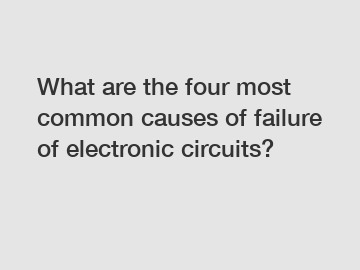What are the four most common causes of failure of electronic circuits?
Electronic circuits are the backbone of our modern world, enabling the seamless functionality of countless devices that we rely on daily. From smartphones and laptops to power grids and automobiles, electronic circuits are essential components in these systems. However, like any technology, they are susceptible to failure. In this blog, we will explore the four most frequent causes of electronic circuit failure, shedding light on the factors that can interrupt their flawless operation.
1. Overheating:
One of the foremost reasons for electronic circuit failure is overheating. Electronic components generate heat during operation, and if the heat is not dissipated efficiently, it can lead to catastrophic consequences. Heat can degrade the performance and lifespan of various components, including transistors, resistors, and capacitors, eventually rendering the circuit inoperable. Poor thermal management, inadequate cooling systems, or operating circuits beyond their thermal limits are common culprits behind overheating. Therefore, careful consideration of thermal design, incorporating appropriate heat sinks, fans, and ventilation, is crucial to prevent overheating-induced failures.

2. Power Surges and Voltage Spikes:
The second major cause that frequently afflicts electronic circuits is power surges and voltage spikes. These sudden fluctuations in electrical supply can wreak havoc on sensitive components, resulting in the malfunction or complete failure of the circuit. Power surges can emanate from lightning strikes, faulty wiring, or external electrical disturbances. To safeguard against this, surge protectors and voltage regulators play a crucial role in stabilizing the incoming power supply, further shielding the circuit from potential destructive forces. Ensuring proper grounding and employing surge protection devices are important steps in protecting electronic circuits against voltage irregularities.
3. Moisture and Contaminants:
Moisture and contaminants present an oft-overlooked source of electronic circuit failure. Humidity, condensation, or exposure to liquids can infiltrate delicate circuitry, leading to short circuits or corrosion of conductive materials. Damp environments, improperly sealed devices, or accidental spills pose significant risks to electronic circuits. Even minute traces of contaminants like dust, dirt, or debris can impede proper functioning by causing electrical shorts or altering component properties. Designing circuits with moisture-resistant coatings, conformal coatings, or hermetic seals, and safeguarding devices against environmental factors can help mitigate these risks.
4. Component Aging and Wear:
As electronic circuits age, their components gradually undergo wear and tear. This natural degradation can diminish their performance and eventually lead to failure. Components such as electrolytic capacitors are particularly prone to aging, resulting in increased leakage, reduced capacitance, and failure. Understanding the lifespan of various components and planning for proactive component replacements or maintenance is crucial to prevent circuit failures due to aging. Regular inspections, adherence to recommended operating conditions, and thorough testing can help identify and replace deteriorating components before they compromise the circuit’s functionality.
Conclusion:
Electronic circuit failures can occur due to a variety of reasons, but understanding the most common causes can help us design more reliable systems and prevent future disruptions. Overheating, power surges, moisture and contaminants, and component aging are the four primary culprits that demand careful consideration during circuit design and operation. Incorporating mitigating strategies such as thermal management, surge protection, moisture-resistant designs, and proactive component replacements can significantly enhance the longevity and reliability of electronic circuits. By addressing these common pitfalls, we can ensure that our electronic devices continue to operate efficiently, elevating our lives in the increasingly connected world we inhabit.
For more SAK-XC2365A-104F80LR AB, AD9280ARS Price & Stock, XC3S400-4PQ208information, please contact us. We will provide professional answers.
109
0
0


Comments
All Comments (0)